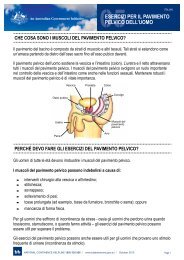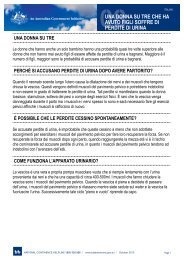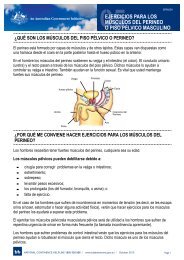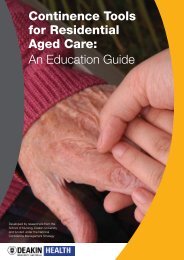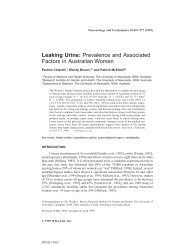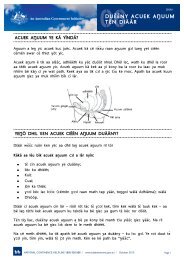Pharmacy Continence Care - Bladder and Bowel Website
Pharmacy Continence Care - Bladder and Bowel Website
Pharmacy Continence Care - Bladder and Bowel Website
Create successful ePaper yourself
Turn your PDF publications into a flip-book with our unique Google optimized e-Paper software.
5.1.2 Addressing the geographically dispersed distribution of community<br />
pharmacies across the nation<br />
Australia has 5000 community pharmacies <strong>and</strong> most local communities have at least one.<br />
Many are the sole provider in a small community <strong>and</strong> a significant proportion are remote<br />
from major urban facilities. For the PCCP to be sustainable <strong>and</strong> to have the maximum effect,<br />
strategies will need to be implemented that address such geographic diversity <strong>and</strong> the lack<br />
of proximity to training <strong>and</strong> information services.<br />
The pilot Program delivered training in three modalities to pharmacies across all jurisdictions,<br />
in metropolitan, regional, rural <strong>and</strong> remote areas. Section 4.2 reports on the pharmacy<br />
perceptions of the training experience <strong>and</strong> of the training benefit. In summary, there were<br />
no perceived differences between the outcomes or results of training in any of these<br />
differing regions. The design of the PCCP training program addressed geographic dispersion<br />
of the participating pharmacies by:<br />
• making the training materials available for download from the project website<br />
• sending a pack of information resources to all pharmacies<br />
• making available the website list of continence physiotherapists located in each region<br />
• making fax <strong>and</strong> telephone contact with each pharmacy. This was particularly useful in<br />
keeping pharmacies engaged in the project, since there are number of different<br />
programs running in pharmacies <strong>and</strong> it is not always easy for staff to distinguish between<br />
them <strong>and</strong> follow through on agreed actions.<br />
The training materials were provided to all the pharmacies regardless of the training method<br />
for each pharmacy. Whilst face-to-face training was the preferred option indicated initially by<br />
pharmacies, the data reported in Section 4.2 indicate that in relation to pharmacy<br />
satisfaction levels with training, there was no significant difference between training types.<br />
Additionally, there was a significant shift in level of perceived confidence, knowledge <strong>and</strong><br />
skills in relation to delivery of continence care services across all training types.<br />
It would be possible, then, to agree on a mode(s) of national delivery based on the one(s)<br />
that will be the most cost effective <strong>and</strong> promote the greatest participation by pharmacies.<br />
The most appropriate options for training that accommodate the nation-wide distribution of<br />
community pharmacies are therefore:<br />
• delivery of self-paced training using web resources, including downloadable consumer<br />
information resources<br />
• contracted provision of group-based training according to a national training calendar,<br />
providing for regular booked group training sessions in diverse metropolitan, regional <strong>and</strong><br />
rural areas. Possible contractors include:<br />
o <strong>Pharmacy</strong> Guilds in each jurisdiction, with contracted continence experts<br />
o Divisions of General Practice<br />
o commercial training services such as those provided by product manufacturers (the<br />
model used in this pilot) that have staff located across Australia.<br />
Implementation of the Program should aim to achieve a substantial level of national<br />
participation by a diverse range of community pharmacies. Setting a high participation target<br />
level would achieve greater visibility of the Program across the Australian community,<br />
enhancing both pharmacy interest <strong>and</strong> sustained participation, <strong>and</strong> consumer awareness of<br />
pharmacy-based continence care. Given the level of interest in participation in the pilot<br />
Program, the availability of evaluated materials <strong>and</strong> training approaches <strong>and</strong> the outcomes in<br />
pharmacy benefit of the pilot, implementation of the Program is proposed over a two-year<br />
Final Report<br />
49<br />
NOVA Public Policy<br />
<strong>Pharmacy</strong> <strong>Continence</strong> <strong>Care</strong> Project



